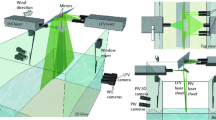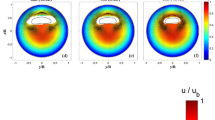Abstract
An experimental method for simultaneously measuring the velocity fields on the air and water side of unsteady breaking waves is presented. The method includes a novel technique for seeding the air flow such that the air velocity can be resolved in the absence of wind. Low density particles that have large Stokes drag and ability to respond to high-frequency flow fluctuations are used to seed the air flow. Multi-camera, multi-laser particle image velocimetry setups are applied to small-scale unsteady breaking waves, yielding fully time-resolved velocity fields. The surface tension of the fluid is altered and controlled to form spilling breaking waves. Results for the velocity and vorticity fields of representative spilling breakers, which show shedding of an air-side vortex and well-documented generation of water-side vorticity, are presented and discussed.










Similar content being viewed by others
References
Adrian RJ (1991) Particle-imaging techniques for experimental fluid mechanics. Annu Rev Fluid Mech 23:261–304
Banner ML, Melville WK (1976) On the separation of air flow over water waves. J Fluid Mech 77:825–842
Chang KA, Liu PLF (1999) Experimental investigation of turbulence generated by breaking waves in water of intermediate depth. Phys Fluids 11(11):3390–3400
Chen DJ (1994) Designing wave–measuring instruments. MIT Master’s Thesis
Chen G, Kharif C, Zaleski S, Li J (1999) Two-dimensional navier-stokes simulation of breaking waves. Phys Fluids 11(1):121–133
Dabiri D, Gharib M. (1997) Experimental investigation of the vorticity generation within a spilling water wave. J Fluid Mech 330:113–139
Duncan JH (2001) Spilling breakers. Annu Rev Fluid Mech 33:519–47
Duncan JH, Qiao H, Philomin V, Wenz A (1999) Gentle spilling breakers: crest profile evolution. J Fluid Mech 379:191–222
de Gennes PG, Brochard-Wyart F, Quéré D (2004) Capillarity and wetting phenomena: drops, bubbles, pearls, waves. Springer, New York
Hendrickson KL (2005) Navier-stokes simulation of steep breaking water waves with a coupled air–water interface. PhD thesis, MIT
Hjelmfelt AT Jr, Mockros LF (1966) Motion of discrete particles in a turbulent fluid. Appl Sci Res 16(1):149–161
Kawai S (1982) Structure of air flow separation over wind wave crests. Boundary Layer Meteorol 23:503–521
Lin JC, Rockwell D (1995) Evolution of a quasi-steady breaking wave. J Fluid Mech 302:29–44
Longuet-Higgins MS (1992) Capillary rollers and bores. J Fluid Mech 240:659–679
McDonald AK (2005) Experimental investigation of small-scale breaking waves: flow visualization across the air–water interface. MIT Master’s Thesis
Melling A (1997) Tracer particles and seeding for particle image velocimetry. Meas Sci Technol 8(12):1406–1416
Melville WK, Veron F, White CJ (2002) The velocity field under breaking waves: coherent structures and turbulence. J Fluid Mech 454:203–233
Peirson WL (1997) Measurement of surface velocities and shears at a wavy air–water interface using particle image velocimetry. Exp Fluids 23(5):427–437
Perlin M, He J, Bernal LP (1996) An experimental study of deep water plunging breakers. Phys Fluids 8(9):2365–2374
Qiao H, Duncan JH (2001) Gentle spilling breakers: crest flow-field evolution. J Fluid Mech 439:57–85
Raffel M, Willert CE, Kompenhans J (1998) Particle image velocimetry: a practical guide. Springer, Berlin
Rapp RJ, Melville WK (1990) Laboratory measurements of deep-water breaking waves. Phil Trans R Soc Lond 331(1622):735–800
Reul N, Branger H, Giovanangeli JP (2008) Air flow structure over short-gravity breaking water waves. Boundary Layer Meteorol 126:477–505
Sankar SV, Kamemoto DY, Bachalo WD (1993) Sizing large hollow micro-balloons with the phase doppler interferometer. Part Part Syst Charact 10:321–331
Siddiqui MHK, Loewen MR (2007) Characteristics of the wind drift layer and microscale breaking waves. J Fluid Mech 573:417–456
Stanislas M, Okamoto K, Kahler C, Westerweel J (2005) Main results of the second international piv challenge. Exp Fluids 39:170–191
Veron F, Saxena G, Misra SK (2007) Measurements of the viscous tangential stress in the airflow above wind waves. Geophys Res Lett 34, L19603. doi:10.1029/2007L031242
Acknowledgments
The authors would like to thank the referees, whose insightful comments served to greatly improve this manuscript. Funding for this work was provided by the Office of Naval Research Young Investigator Program, Dr. Patrick Purtell, Grant N00014-04-1-0609.
Author information
Authors and Affiliations
Corresponding author
Rights and permissions
About this article
Cite this article
Belden, J., Techet, A.H. Simultaneous quantitative flow measurement using PIV on both sides of the air–water interface for breaking waves. Exp Fluids 50, 149–161 (2011). https://doi.org/10.1007/s00348-010-0901-5
Received:
Revised:
Accepted:
Published:
Issue Date:
DOI: https://doi.org/10.1007/s00348-010-0901-5




